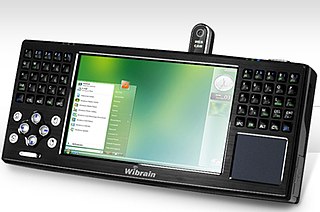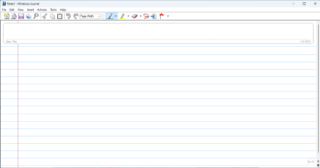 W
WMicrosoft Tablet PC is a term coined by Microsoft for tablet computers conforming to a set of specifications announced in 2001 by Microsoft, for a pen-enabled personal computer, conforming to hardware specifications devised by Microsoft and running a licensed copy of Windows XP Tablet PC Edition operating system or a derivative thereof.
 W
WThe HP Compaq TC1100 is a tablet PC sold by Hewlett-Packard that was the follow-up to the Compaq TC1000. The TC1100 had either an Intel Celeron or an Intel Pentium M chip set and could be upgraded up to 2 gigabytes of memory. The switch from Transmeta Crusoe processors to the Pentium M and the ability to add memory was welcomed after numerous complaints about the poor performance of the TC1000. The TC1100 was the last version from HP in this style of tablet. It was replaced by the HP Compaq TC4200, which featured a more traditional one-piece design.
 W
WThe HP Compaq TC4200 is a Tablet PC that was released on March 1, 2005 and has since been discontinued. It is believed to be the successor to the TC1100, which was discontinued in Q4 of 2005. The TC4200 boasted many powerful features that could be found on mid to high-range laptops and competing tablets during its production. The TC4200 was superseded by the similar HP Compaq TC4400.
 W
WThe HP Compaq TC4400 is a tablet-style personal computer. It can be used in the position of a normal laptop or the screen can be turned and folded down for writing.
 W
WThe HP Stream 7 is a tablet computer designed by Hewlett-Packard that runs the Windows operating system. It was announced on September 29, 2014.
 W
WHP TouchSmart is a series of tablet PC laptops and touchscreen all-in-one desktop computers designed by HP. It features various Intel or AMD processors and runs Windows Vista or Windows 7 as standard.
 W
WThe Pepper Pad was a family of Linux-based mobile computers with Internet capability and which doubled as a handheld game console. They also served as a portable multimedia device. The devices used Bluetooth and Wi-Fi technologies for Internet connection. Pepper Pads are now obsolete, unsupported and the parent company has ceased operations.
The Soft Input Panel is a special on-screen input method for devices which do not have standard keyboards. SIP is commonly used in Microsoft Pocket PC and Tablet PC devices, where there is no room for a keyboard. In Microsoft Windows there is a similar on-screen keyboard used as a Microsoft Active Accessibility (MSAA) which also has an ability to change its layout according to current keyboard language and key layout. It was patented by Microsoft in November 2004 under the patent number 6819315.
 W
WThe ThinkPad X series is a line of laptop computers and convertible tablets produced by Lenovo. It was initially produced by IBM until 2005.
 W
WAn ultra-mobile PC is a miniature version of a pen computer, a class of laptop whose specifications were launched by Microsoft and Intel in spring 2006. Sony had already made a first attempt in this direction in 2004 with its Vaio U series, which was however only sold in Asia. UMPCs are generally smaller than subnotebooks, have a TFT display measuring (diagonally) about 12.7 to 17.8 cm, are operated like tablet PCs using a touchscreen or a stylus, and can also have a physical keyboard. There is no clear boundary between subnotebooks and ultra-mobile PCs, but UMPCs commonly have form factors other than the common clamshell laptop design, such as having small keys on either side of the screen, or having a slide-out keyboard.
 W
WWindows for Pen Computing is a software suite for Windows 3.1x, that Microsoft designed to incorporate pen computing capabilities into the Windows operating environment. Windows for Pen Computing was the second major pen computing platform for x86 tablet PCs; GO Corporation released their operating system, PenPoint OS, shortly before Microsoft published Windows for Pen Computing 1.0 in 1992.
 W
WWindows Journal is a discontinued notetaking application, created by Microsoft and included in Windows XP Tablet PC Edition as well as select editions of Windows Vista and later. It allowed the user to create and organize handwritten notes and drawings, and to save them in a .JNT file, or export them in TIFF format. It can use an ordinary computer mouse to compose a handwritten note, as well as a graphics tablet or a Tablet PC.